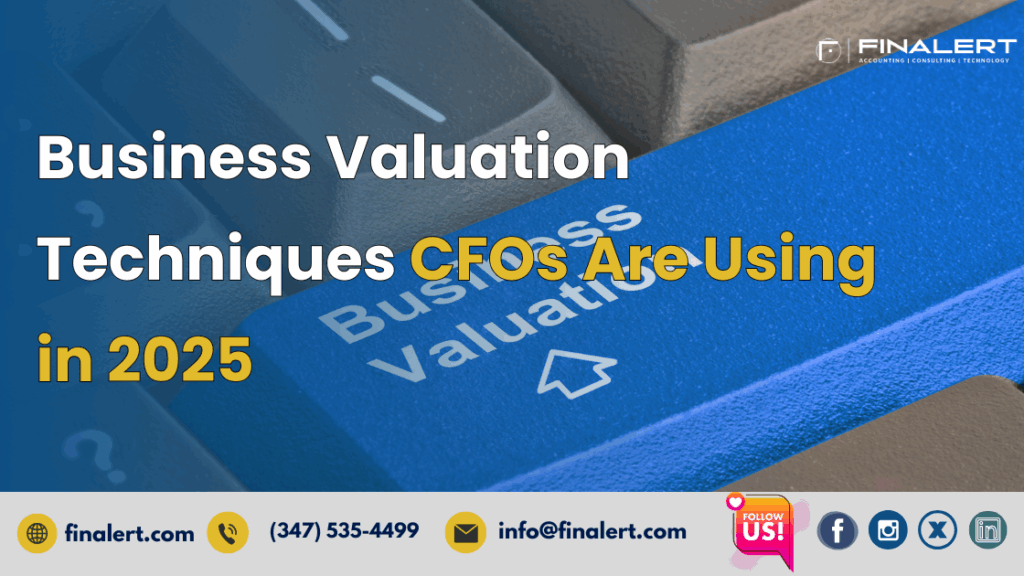
In 2025, accurate business valuation is more critical and complex than ever. With shifting market conditions, evolving investor expectations, and heightened M&A activity across industries, companies need to know where they stand financially. Whether preparing for a funding round, a sale, equity compensation, or internal strategic planning, an accurate valuation provides the foundation for informed decisions.
But valuation is not one-size-fits-all. Chief Financial Officers (CFOs), especially fractional and outsourced CFOs working with startups and mid-sized businesses, now use a blend of traditional and modern valuation techniques. These approaches factor in financial performance, growth potential, market comparables, and even intangible assets like brand strength or recurring revenue.
In this article, we explore the business valuation techniques CFOs are using in 2025, why each method matters, and how business owners can prepare for a reliable, investor-ready valuation.
Business valuation isn’t just for investors or exit planning. In 2025, CFOs use valuation for:
A credible valuation helps business leaders justify their business strategy, pricing models, and growth forecasts to stakeholders and potential buyers. More importantly, it prevents over- or undervaluation that could lead to misaligned expectations or lost opportunities.
The Discounted Cash Flow (DCF) method remains a cornerstone of valuation in 2025. It estimates a company’s value based on projected future cash flows, adjusted for the time value of money.
Example: A SaaS company with consistent recurring revenue might forecast $5M in free cash flow in year 5. Using a discount rate of 10%, CFOs calculate what that stream is worth today.
CFOs often use comparable company analysis, or “comps,” to value businesses based on how similar companies are priced in the market.
Example: If SaaS companies with $2M ARR trade at 8x revenue, your business might be valued near $16M.
Similar to comps, precedent transaction analysis looks at actual past acquisitions of similar businesses to estimate value.
Example: If another e-commerce business was acquired for 2x revenue, and yours has similar metrics, it provides a credible valuation benchmark.
In high-growth sectors like SaaS, valuation is often driven by revenue multiples, particularly when earnings are negative or break-even.
| Business Type | Revenue Multiple (Range) |
|---|---|
| B2B SaaS (high growth) | 6x – 12x ARR |
| E-commerce | 1x – 3x revenue |
| Consumer subscription | 3x – 7x MRR |
| Service businesses | 0.5x – 1.5x revenue |
Note: CFOs normalize these multiples for retention, margin, and efficiency metrics like CAC/LTV and burn multiple.
An asset-based valuation values a business based on the fair market value of its net assets (assets – liabilities).

For startups issuing stock options, the IRS requires a 409A valuation to determine the fair market value of common stock for compliance.
Note: While not used for fundraising valuation, the 409A must align with broader company financials and projections.
The Rule of 40 is a heuristic used in SaaS to evaluate a company’s combined growth and profitability.
Formula:
Revenue Growth Rate + EBITDA Margin ≥ 40%
Example: If your ARR is growing 60% per year but your EBITDA margin is –25%, your Rule of 40 score is 35%. That might lower your multiple compared to a peer with more balanced growth.
CFOs in 2025 go beyond numbers to assess valuation drivers like:
These qualitative factors often shift valuation by 10–30%, and experienced CFOs know how to present or mitigate them effectively.
CFOs are not just number crunchers; they’re storytellers. They ensure the valuation model aligns with your:
They build sensitivity tables, best-case/worst-case models, and summary slides to help founders defend valuation during investor meetings or M&A discussions.
CFOs in 2025 leverage software to automate and visualize valuation metrics. Common tools include:
Automation speeds up modeling, but human interpretation remains essential.
To support a successful valuation process, CFOs advise founders to:
A solid foundation improves valuation outcomes and investor confidence.
In 2025, CFOs combine analytical rigor with industry expertise to produce reliable and defensible business valuations. From discounted cash flow to revenue multiples and precedent deals, valuation is no longer a static exercise; it’s a strategic tool for growth, investment, and exit.
Whether you’re seeking funding, structuring equity, or exploring a sale, the right valuation approach led by an experienced CFO ensures you’re not leaving money or opportunity on the table.
In today’s fast-paced business environment, understanding your worth isn’t just about numbers; it’s about positioning, potential, and planning for what’s next.
Similar Articles
No results available
Get in touch with Finalert today for tailored business solutions!
No results available
Ready to thrive? Connect with Finalert today and let’s succeed together in the dynamic global market.
© 2025 Finalert. All rights reserved.
Ready to thrive in the dynamic global market? Finalert LLC offers expert financial services, including accounting, consulting, and technology solutions, tailored to your business needs.
Address
Accounting
Quick Links
Consulting
Industries
© 2025 Finalert LLC. All rights reserved.